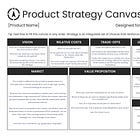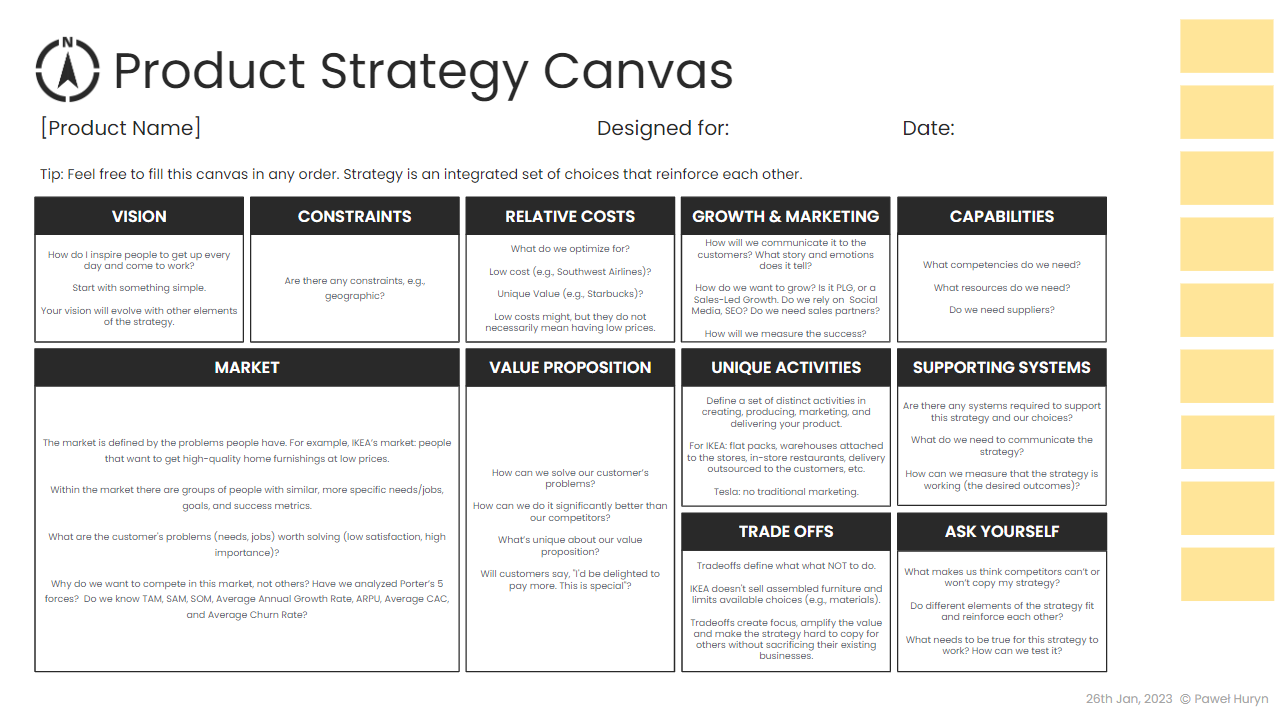Introducing the Product Strategy Canvas
After 5 months, I could not find a single Product Strategy Canvas I could recommend. So here is a new one.
Edited 8/4/2023
⚡ There is a new version of this issue (v1.1):
The archived version (v1.0)
Before we dive in, the Strategy is simple. And it’s for everyone in the organization. But, contrary to what many believe, it’s not:
A plan (“we will build a new division”).
A goal (“we want to grow by 50% by 2024”).
An ambition (“we want to be the best”).
An action (“disable that feature”).
An OKR.
A Business Model.
A Unique Value Proposition.
Many companies do not have a strategy at all.
A good Strategy
Defines a long-term vision (winning aspiration)
Is a single, integrated set of choices that reinforce each other and increase your odds of success
Defines the market (problems) and your playing field’s constraints
Focuses on customers whom you can’t control
Has a theory on how to persuade them to do what you want
Explains what competencies, resources, and systems you need
Passes the Can’t/Won’t Test. Your competitors can’t or won’t copy it
Has many levels (organization/division/team)
Allows you to formulate hypotheses
Why the new Product Strategy Canvas?
After 5 months, I could not find a single Product Strategy Canvas I could recommend. So I created a new one.
It’s based primarily on the work of Michael Porter and Martin Roger, in particular, Understanding Michael Porter and Playing to Win.
Thanks for your review and great insights. I'm happy to receive more feedback from others.
In the meantime, anyone can get inspired by even more questions (tooltips).
You can download a free PDF version in my PM Templates.
Questions you need to answer to fill in the Product Strategy Canvas
Feel free to fill this canvas in any order. Strategy is an integrated set of choices that reinforce each other.
1. VISION
How do I inspire people to get up every day and come to work?
Start with something simple. Your vision will evolve with other elements of the strategy.
2. MARKET
The market is defined by the problems people have. For example, IKEA’s market: people that want to get high-quality home furnishings at low prices.
Within the market, there are groups of people with similar, more specific needs/jobs, goals, and success metrics.
What are the customer’s problems (needs, jobs) worth solving (low satisfaction, high importance)?
Why do we want to compete in this market, not others? Have we analyzed Porter’s 5 forces? Do we know TAM, SAM, SOM, Average Annual Growth Rate, ARPU, Average CAC, and Average Churn Rate?
3. CONSTRAINTS
Are there any constraints, e.g., geographic?
4. RELATIVE COSTS
What do we optimize for?
Low cost (e.g., Southwest Airlines)?
Unique Value (e.g., Starbucks)?
Low costs might, but they do not necessarily mean having low prices.
5. VALUE PROPOSITION
How can we solve our customer’s problems?
How can we do it significantly better than our competitors?
What’s unique about our value proposition?
Will customers say, “I’d be delighted to pay more. This is special”?
6. GROWTH & MARKETING
How will we communicate it to the customers? What story and emotions does it tell?
How do we want to grow? Is it PLG, or a Sales-Led Growth. Do we rely on Social Media, SEO? Do we need sales partners?
How will we measure the success?
7. UNIQUE ACTIVITIES
Define a set of distinct activities in creating, producing, marketing, and delivering your product.
For IKEA: flat packs, warehouses attached to the stores, in-store restaurants, delivery outsourced to the customers, etc.
Tesla: no traditional marketing.
8. TRADE-OFFS
Trade-offs define what NOT to do.
IKEA doesn’t sell assembled furniture and limits available choices (e.g., materials).
Tradeoffs create focus, amplify the value and make the strategy hard to copy for others without sacrificing their existing businesses.
9. CAPABILITIES
What competencies do we need?
What resources do we need?
Do we need suppliers?
10. SUPPORTING SYSTEMS
Are there any systems required to support this strategy and our choices?
What do we need to communicate the strategy?
How can we measure that the strategy is working (the desired outcomes)?
11. ASK YOURSELF
What makes us think competitors can’t or won’t copy my strategy?
Do different elements of the strategy fit and reinforce each other?
What needs to be true for this strategy to work? How can we test it?
Working with the Product Strategy Canvas
Discovering the market:
[Book] The Lean Product Playbook
[Book] Jobs-to-Be-Done
Analyzing the market and the business environment:
[Framework] Porter’s Five Forces
[Framework] PESTEL Analysis
[Framework] SWOT Analysis
Creating Value Proposition:
[Book] The Lean Product Playbook
[Book] Value Proposition Design
Testing Value Proposition:
[Book] The Lean Product Playbook
[Book] Testing Business Ideas
Analyzing Unique Activities:
[Framework] Value Chain Analysis
Growth strategies:
[Framework] Ansoff Matrix
Analyzing strategy (Porter’s fit test):
[Framework] McKinsey 7S Framework
All Frameworks: My LinkedIn article
Conclusions
Don’t seek perfection. Strategy is a set of choices that increase your odds of success in the future. And the future is unknown.
If you are stuck and your Strategy doesn’t work, learn from it. Go back, iterate, and test again.
Hope that helps.
Final notes
In Bad Strategy & Good Strategy, Richard Rumelt suggested that strategy should contain Coherent Actions. I decided to exclude them, as this is not in line with Porter’s and Roger’s definitions. Strategy is an integrated set of choices, not a plan, and not a set of activities.
In Product, we tend to split Product Vision and Product Strategy. But I feel convinced by Martin Roger - you need to define your vision ("Winning Aspiration") together with the other elements of the Strategy, not one after another.
A Business Model (how exactly you make money) is not a strategy. Strategy informs you about your relative costs and revenues. We can say that the Business Model emerges from the Strategy. Both are important.
A Unique Value Proposition alone is not a Strategy. In my opinion, The Blue Ocean Strategy Canvas is not a Strategy Canvas. This is supported by Porter’s and Roger’s work.
Thanks for reading The Product Compass!
Liked this post?
Subscribe now and upgrade to accelerate your PM career. You will get 1 actionable piece of advice for PMs every week.
Premium subscriber benefits:
My full archive and all PM resources
Enroll in Continuous Product Discovery Masterclass + certificate
Join our closed Slack community + get my help anytime (1:1)
Clone my Notion collection to your Notion account
30-days money-back guarantee
Let’s learn and grow together.
Take care, Paweł




